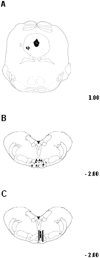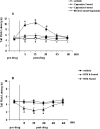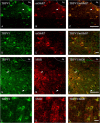Tonic endovanilloid facilitation of glutamate release in brainstem descending antinociceptive pathways
- PMID: 18077685
- PMCID: PMC6673635
- DOI: 10.1523/JNEUROSCI.3258-07.2007
Tonic endovanilloid facilitation of glutamate release in brainstem descending antinociceptive pathways
Abstract
Activation of transient receptor potential vanilloid-1 (TRPV1) channels in the periaqueductal gray (PAG) activates OFF antinociceptive neurons of the rostral ventromedial medulla (RVM). We examined in rats the effect of intra-ventrolateral (VL)-PAG injections of TRPV1 agonists and antagonists on the nocifensive response to heat in the plantar test, neurotransmitter (glutamate and GABA) release in the RVM, and spontaneous and tail flick-related activities of RVM neurons. The localization of TRPV1 in VL-PAG and RVM neurons was examined using various markers of glutamatergic and GABAergic neurons. Intra-VL-PAG injection of capsaicin increased the threshold of thermal pain sensitivity, whereas the selective TRPV1 antagonist 5'-iodo-resiniferatoxin (I-RTX) facilitated nociceptive responses, and blocked capsaicin analgesic effect at a dose inactive per se. Intra-VL PAG capsaicin evoked a robust release of glutamate in RVM microdialysates. I-RTX, at a dose inactive per se, blocked the effect of capsaicin, and inhibited glutamate release at a higher dose. Antinociception and hyperalgesia induced by capsaicin and I-RTX, respectively, correlated with enhanced or reduced activity of RVM OFF cells. Immunohistochemical analyses suggested that several TRPV1-immunoreactive (ir) neurons in both the VL-PAG and RVM are glutamatergic and surrounded by glutamatergic and GABAergic terminals. Our data suggest that VL-PAG neurons respond to TRPV1 stimulation by releasing glutamate into the RVM, thereby activating OFF cells and producing analgesia. The results obtained with the TRPV1 antagonist alone suggest that this pathway is tonically activated by endovanilloids.
Figures









Similar articles
-
Functional interaction between TRPV1 and mu-opioid receptors in the descending antinociceptive pathway activates glutamate transmission and induces analgesia.J Neurophysiol. 2009 May;101(5):2411-22. doi: 10.1152/jn.91225.2008. Epub 2009 Mar 18. J Neurophysiol. 2009. PMID: 19297510
-
Diabetic thermal hyperalgesia: role of TRPV1 and CB1 receptors of periaqueductal gray.Brain Res. 2010 Apr 30;1328:49-56. doi: 10.1016/j.brainres.2010.02.077. Epub 2010 Mar 6. Brain Res. 2010. PMID: 20211611
-
TRPV1 receptor mediates glutamatergic synaptic input to dorsolateral periaqueductal gray (dl-PAG) neurons.J Neurophysiol. 2007 Jan;97(1):503-11. doi: 10.1152/jn.01023.2006. Epub 2006 Oct 25. J Neurophysiol. 2007. PMID: 17065246
-
Role of TRPV1 receptors in descending modulation of pain.Mol Cell Endocrinol. 2008 Apr 16;286(1-2 Suppl 1):S79-83. doi: 10.1016/j.mce.2008.01.013. Epub 2008 Feb 2. Mol Cell Endocrinol. 2008. PMID: 18325659 Review.
-
Moving towards supraspinal TRPV1 receptors for chronic pain relief.Mol Pain. 2010 Oct 11;6:66. doi: 10.1186/1744-8069-6-66. Mol Pain. 2010. PMID: 20937102 Free PMC article. Review.
Cited by
-
Capsaicin: Current Understanding of Its Mechanisms and Therapy of Pain and Other Pre-Clinical and Clinical Uses.Molecules. 2016 Jun 28;21(7):844. doi: 10.3390/molecules21070844. Molecules. 2016. PMID: 27367653 Free PMC article. Review.
-
Polymodal activation of the endocannabinoid system in the extended amygdala.Nat Neurosci. 2011 Nov 6;14(12):1542-7. doi: 10.1038/nn.2974. Nat Neurosci. 2011. PMID: 22057189
-
Blockade of Cannabinoid CB1 Receptors in the Dorsal Periaqueductal Gray Unmasks the Antinociceptive Effect of Local Injections of Anandamide in Mice.Front Pharmacol. 2017 Oct 4;8:695. doi: 10.3389/fphar.2017.00695. eCollection 2017. Front Pharmacol. 2017. PMID: 29046638 Free PMC article.
-
Capsaicin protects mouse neuromuscular junctions from the neuroparalytic effects of botulinum neurotoxin a.J Pharmacol Exp Ther. 2009 Nov;331(2):361-71. doi: 10.1124/jpet.109.156901. Epub 2009 Aug 4. J Pharmacol Exp Ther. 2009. PMID: 19654265 Free PMC article.
-
Bulbospinal nociceptive ON and OFF cells related neural circuits and transmitters.Front Pharmacol. 2023 Apr 20;14:1159753. doi: 10.3389/fphar.2023.1159753. eCollection 2023. Front Pharmacol. 2023. PMID: 37153792 Free PMC article. Review.
References
-
- Azkue JJ, Mateos JM, Elezgarai I, Benitez R, Lazaro E, Streit P, Grandes P. Glutamate-like immunoreactivity in ascending spinofugal afferents to the rat periaqueductal grey. Brain Res. 1998;790:74–81. - PubMed
-
- Basbaum AI, Fields HL. Endogenous pain control systems: brainstem spinal pathways and endorphin circuitry. Annu Rev Neurosci. 1984;7:309–338. - PubMed
-
- Behbehani MM. Functional characteristics of the midbrain periaqueductal gray. Prog Neurobiol. 1995;46:575–605. - PubMed
-
- Behbehani MM, Fields HL. Evidence that an excitatory connection between the periaqueductal gray and nucleus raphe magnus mediates stimulation produced analgesia. Brain Res. 1979;170:85–93. - PubMed
MeSH terms
Substances
LinkOut - more resources
Full Text Sources
Medical
